Text
OH MY GOD
Do you need more proof that S4 is fucking fake? And more likely a drug induced coma fever dream?
Remember E? The woman on the bus that "Eurus" pretended to be and had a text affair with John? How did she give John her number? Written on a piece of paper. And what was her number?

I always wondered if there was a signiificance to this phone number. I looked for meta on this but never found a one with proper proofs, forgive me if I overlooked any and please let me know if so. As is with this ridiculous show that even after re-watching it for the 143rd time, I still get baffled at things I didn't notice before!
And I cannot believe that this number comes from

The Hounds of Baskerville
Henry Knight's napkin with the train girl's phone number on it.
Sherlock: The girl – female handwriting’s quite distinctive. Wrote her phone number down on the napkin. I can tell from the angle she wrote at that she was sat across from you on the other side of the aisle. Later – after she got off, I imagine – you used the napkin to mop up your spilled coffee, accidentally smudging the numbers. You’ve been over the last four digits yourself with another pen, so you wanted to keep the number. Just now, though, you used the napkin to blow your nose. Maybe you’re not that into her after all.

E was sitting across from John on the other side of the aisle on the bus. And it seemed she already had the number written down the way she is looking at the piece of paper, she probably just wrote Exx at the bus stop scene. John contemplated throwing her number in the bin but then decided to keep it after all.
What does this tell me? A clear indication that S4 is an amalgamation of what THoB is essentially all about - re-written memories due to childhood trauma, drug induced hallucinations, doing therapy (Sherlock's recurring dream), on the verge of suicide, not knowing what's real and what's not, betrayed by someone close - we know what Henry Knight saw was never real, the HOUND was never real. We also know Henry Knight is a Sherlock mirror.
If you notice the phone number screen grab from THoB, the 3rd last and 2nd last number seem to "1 and 5" that is rewritten by Henry, the last number is not visible to us. The last three numbers on E's number is "552".
"You’ve been over the last four digits yourself with another pen..."
This is Sherlock's version, he has rewritten this with his pen. All of S4.
498 notes
·
View notes
Text
damn.
the reason why sherlock couldnt remember sholto’s room number and the reason why sherlock had to consult notes for his speech is because he filled his mind palace completely. why would he do this for johns wedding. why did he want to retain nothing in his mind palace of john getting married. why doesnt he want to remember
60 notes
·
View notes
Text
very interesting indeed.
Random facts that make you go:
Wait... what?
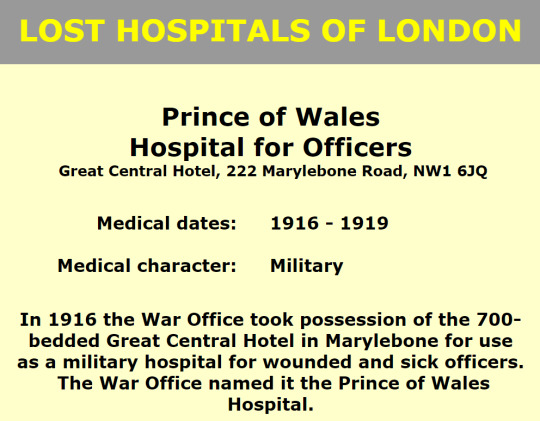


154 notes
·
View notes
Text
If Sherlock and John died on the train in The Empty Hearse… (by yours truly)
“two men of note who never lived
and so can never die.” and yet alas,
faced with the indisputable end.
remember remember, reminiscence
of thrill and adventure
the danger was a given and
death a definite destination
for those who walk with the baker street
kamikaze’s until death do us part
Once had been a revenant
faced with the terminal of existential nihilism just as he was latching onto the
prospect that perhaps there was a worth
and now that worth has moved on and
Bach would not be pleased with
an unfinished song.
‘Erbarme dich, mein Gott,’
the game was destined for tragedy
be-known to the player who fell
for the equivocation of the devil
‘Erbarme dich, Erbarme dich’
The timer drops in number
closer to the denouement
and neither will speak past that
of Freudian depth, that of 1895.
there’s something he should say
to the worth who turns his back
uncomprehending of his death,
Because he feels it too,
but words are minute
to the scale of the atomic bomb
which proceeds in landing.
#sherlockbbc#sherlock#sherlock holmes#benedict cumberbatch#johnlock#mofftiss#martin freeman#bbc sherlock#i am sherlocked
6 notes
·
View notes
Text
i love this parallel
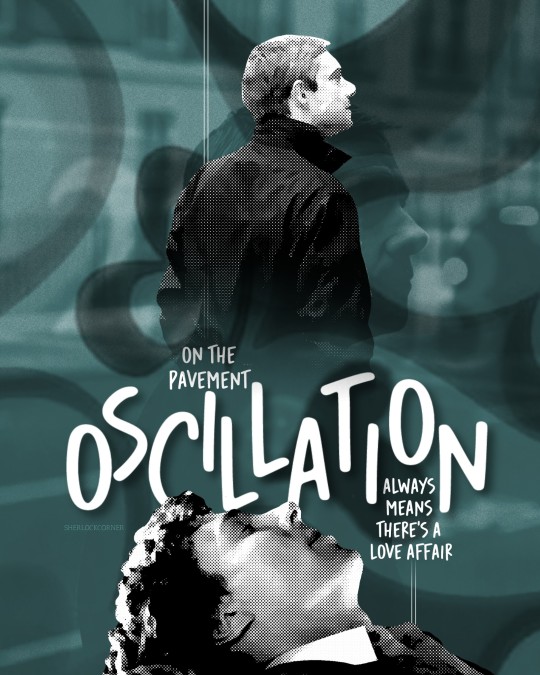
"Oscillation on the pavement always means there's a love affair."
179 notes
·
View notes
Text
this.
I wish I could draw so I could draw Sherlock chip out Johns head in paper and glue it on da-Vinci’s’ man
13 notes
·
View notes
Text
Sometimes she asks me Sherlock. She says “daddy, what was mummy like?” and my stomach sinks. She asks “did you love mummy?” and it hurts because I didn’t, because I loved you.
6 notes
·
View notes
Text
Mycroft’s romance film in TFP.
I don’t usually rewatch BBC Sherlocks’ The Final Problem… nor season 4 for that matter, but recently I revisited the awkward season and when it came to the early scenes in the finale episode, I couldn’t help but laugh over the fact that Mycroft’s romantic film he watches ends up being corrupted… which is already pretty telling on a ground level analysis, especially considering Mycroft is played by Mark Gatiss, the literal writer.

Naturally, I investigated further into the film that is used in an attempt to see if the plot line possibly matches/ mirrors that of Sherlock and John. However I found out that the film was in fact made by Mark and Steven. In response to the question, Ian Hallard (Marks husband) responded:
I'm not sure they gave it a name! It's a film noir
pastiche they wrote and shot themselves
though - not an existing film.
So… in some way this makes things more interesting. I find it very unlikely that they didn’t leave us little clues and subplots intermingled within the romance. With that being said, I decided to analyse the scene, and this is my findings…
The plot of the romance.
From the short clip we get, we can gather that a woman is heavily flirting with a police officer in his office whom he returns the flirting.

The woman insists she will be arrested by the man (in a seductive tone of manner) and he replies that he will not arrest her, only keep a very… very… close eye on her… (if you get my drift.)
Props and design.
The first thing I noticed in the backdrop led me to immediately link the man with another character. It was a globe in the background which reminded me of Mycroft’s in his office.

And then in Mycroft’s office (TEH)
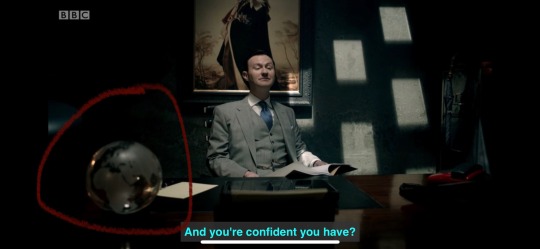
Furthermore, the lamp closely resembles Mycroft’s which we see in The Six Thatchers. The fact that both of them have an office and hold authority in some kind of civil occupation makes it quite an obvious mirroring.
Who’s the woman then?
I think that the woman represents Moriarty. Her characteristics and flirty manner to higher ranks perfectly matches Moriarty, who we see uses seduction and ‘love’ to gain closure on Sherlock. This is evidenced with himself posing as Molly’s boyfriend to meet Sherlock and Kitty’s boyfriend to expose Sherlocks public image through the media. Moriarty flirts a hell of a lot with Sherlock in the pool scene (TGG) and also makes sex references with the governor in the flashback scene in The Final Problem.
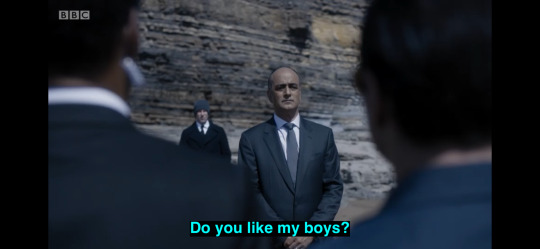

Keeping the M theory in mind that Moriarty manipulates and threatens Mycroft into giving information about Sherlock, it’s not impossible that Jim keeps up with his flirty attitude with Mycroft … in fact it’s made explicit that he does and we are shown this in the flashback too.

But the man quite clearly flirts back in the film? This is a tricky one but it’s pretty clear that Mycroft underestimates Moriarty’s power in the beginning of the series. Perhaps he plays along to (in his mind) humour the idea that Jim has already won to give the perception he is less smarter than he gives on. This is until he got too deep in the threats and manipulation and finds himself messed up in the web. The man also finds himself having to hold back in the film as well when things get a little too risky.


So we have established that The man is a Mycroft mirror and the woman is a Moriarty mirror. But what can we take away from it? I’ll start at the beginning and make my way through :)
A CHRONOLOGICAL ANALYSIS.
The scene begins with the following:
Man- You know I could arrest you.
woman- What for?
man- Wearing a dress like that.
woman- Would you like me to take it off?
man- Then i’d really have to press charges.
Woman- Press away.
Prior to The Reichenbach Fall in season 2, we are aware that Mycroft has been trying to keep Sherlock safe from Moriarty. In fact, in the end of The Hound Of The Baskervilles, Moriarty has been in a cell before Mycroft says “Let him go.”
We can assume they wanted the none existent “key code” which in unlikely because I don’t think Mycroft would be so naïve. So I think what the scene tells us is that Mycroft had no hard evidence to put Moriarty behind bars. No matter what he accuses him of, Moriarty is already ahead of him, and he almost mocks Mycroft. “Would you like me to take it off?” because he knows he can play the Government and the Secret service, they have nothing on him.
In The Final Problem flashback, Mycroft tells Moriarty: “Until you commit a verifiable crime, you are, I regret, at liberty.”
Then the camera angle changes so that we see the projector light blinding us so that Mycroft is barely visible.
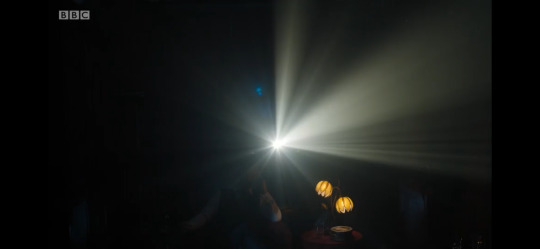
The two dim lights appear to look like dying flowers, representative of Mycroft’s dying power and authority. The blinding light corresponds to the blind ignorance and stupidity that Mycroft held for not realising he was being played.
woman- Isn’t that how they got started?
man- Who? (The camera cutes to Mycroft)
woman- Adam and Eve.
man- Oh them.
woman- And that turned out ok.
man- You think so? I thought it was supposed to be the beginning of all human misery.
The use of “they” makes me wonder who they are referring to… if not Adam and Eve. I’m not too sure on this one to be honest with you. Could Adam and Eve represent Sherlock and John? Of the top of my head, Mark Gatiss could be referring to the ACD Sherlock Holmes because its the first fabrication of these characters. I can’t seem to link them to the previous lines though, however the next line “Oh, them.” is a line that Mycroft (Mark) lip-sinks.

That’s why I assume we are talking about Sherlock and John because of the ironic smile and knowing shake of the head. He also happens to lip-sinks “You think so? I thought it was supposed to the beginning of all human misery.” With the continuation of Adam and Eve as the first Sherlock and John, this implies that, as a result of Moriarty, Mycroft questions the sanity of of his brother and John.
Mycroft then takes a sip of alcohol, whether it be whisky or brandy...
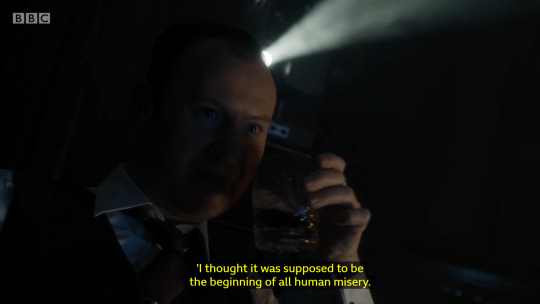
Despite his cool façade, The Drink Code suggests that taking hard alcohol means fear. Mycroft fears for Sherlock and feels as if he has been caught in Moriarty’s web, leaving his younger brother suggestable and in danger. Human misery.
The camera then turns back to the film.
woman- Now what was all that about arresting me?
This line from the woman closely resembles that of Moriarty in The Final Problem when he is at Sherrinford with Mycroft.
“So am I under arrest again?” To which Mycroft says: “You remain a person of interest.”
The camera closes in on Mycroft once again, articulating the idea that Mycroft wanted to arrest Moriarty. He even smiles at the idea.

man- well maybe not arresting you.
woman- no?
man- I could just keep you under close watch.
The camera returns to Mycroft once more. This was maybe his error. Letting Moriarty go free and underestimating his danger. He thought if he just kept an eye on what he thought (which was indefinitely a mis-calculation) Moriarty was up to, he would keep himself and Sherlock safe...
Following this line, Mycroft and us witness the first corrupted glitch which we know after to be Sherlock and John. However, it’s quite ironic that it occurs at the same point at which Mycroft makes his error in letting Moriarty be liberated.

After a few corrupted scenes, Mycroft frowns and looks behind at the projector. He turns to the blinding light of ignorance and sees what has happened to him.
Meanwhile:
woman- shame I was looking forward to putting myself into the hands of the authorities.
If that doesn’t sound like Moriarty then I don’t know what does! It makes if even better that at this exact point, the camera shows a close up of a rather worried Mycroft.
man- you were?
woman- finger-printing, being searched... thoroughly.
Again, it’s the spitting image of Moriarty!
The film glitches between a young Mycroft and the woman, furthermore proving some kind of link between these two.
Then Mycroft appears to lose his disturbance when an extended clip of the Holmes family plays before his whole nostalgia is corrupted..
“I’m back.”
#sherlock#sherlock holmes#acd canon#bbc sherlock#sherlock icons#mark gatiss#mofftiss#theory#benedict cumberbatch#martin freeman#season 4#the final problem
41 notes
·
View notes
Text
WHO DID CONAN DOYLE BASE SHERLOCK HOLMES ON?
The great detective’s inspiration has been the subject of conversation for decades and although there has not been a freakishly talented detective with the name Sherlock Holmes in the 19th century, there has been close associates in Doyles life which could have been potential inspiration for his persona.

(Sir Arthur Conan Doyle- world history archive)
1. Charles Doyle
Arthur’s own father, Charles could have definitely influenced the characteristics of Sherlock Holmes. He, himself, suffered with “manic depression”- or what we could call bipolar, much like Holmes was evident to have.
Charles was also described as a chronic alcoholic who got became very violent frequently. Much like Holmes, he was constantly restless and relied on alcohol to get by as did Holmes with his 7% solution of cocaine and opium addiction.
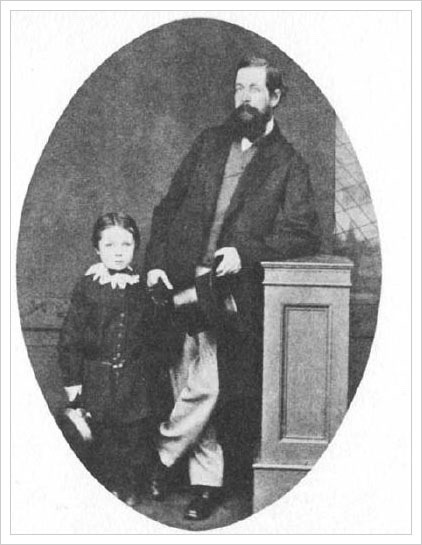
(Charles Altamont Doyle with his 3rd child, Arthur Doyle -may 1865)
In fact, alcoholism and substance abuse often comes up in Sherlock Holmes and often has darker connotations that reflect on Doyles characters. An example of this comes from ‘The Blue Carbuncle’ in The Adventures Of Sherlock Holmes in which character Henry Baker, an elderly man, loses his hat and goose in a row on the street. After fleeing the scene, Holmes receives said hat and deduces:
“He had foresight, but has less now than formerly, pointing to a moral retrogression, which, when taken with the decline of his fortunes, seems to indicate some evil influence, probably drink, at work upon him. This may account also for the obvious fact that his wife has ceased to love him.”
Perhaps, Sherlocks deductions reflect the relationship between his father and the rest of the Doyle family.
2. Dr. Brian Charles Waller
In 1875, the Doyle family suffered from financial difficulties and were headed towards the direction of a bankruptcy that could leave them in the dreaded work house. However, they were saved by a lodger names Brain Waller who spared them with the rent he payed.

(At the time, the Doyle family were living in tenement flats in Sciennes, Edinburgh)
Waller had quite the influence on 16 year old Arthur and had persuaded him to go onto study medicine. One significant fact about the lodger was that he gave himself the name ‘consulting pathologist’ which parallels Sherlocks self acclaimed ‘consulting detective’ title.
He was also said to show off so much that he was very unlikeable and aware of his own knowledge which is very much like Holmes as he is known to use deductions that leave others irritated when they are left exposed.
Apparently, Conan Doyle and Waller did not get on well, however it seems this was because of Brians relations with his family. Waller was speculated to have fallen for Arthurs older sister and to have also had an affair with Arthurs mother, Mary Doyle which made him resent Brain even more.
3. Dr. Joseph Bell
Conan Doyle attended Edinburgh University in 1876 to study medicine where he met Dr. Joseph bell, a surgeon and lecturer.
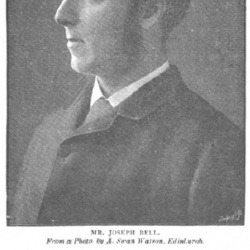
(Joseph Bell in 1892)
Joseph, himself was very much like Sherlock within his own deductive skill. He could look at patients and make observations and even diagnosis without the patient explaining themselves. Even more impressively, he could identify the patients nationality and occupation as well.
In 1929, Conan Doyle confirmed Joseph Bell as a influence on Sherlock Holmes in an interview, where he said:
“I thought to myself, well if a scientific man like Bell was to come into the detective business, he wouldn’t do things by chance, he’d get the thing by building it up scientifically, so having once conceived that line of thought, you can [well] imagine that I had, as it were, a new idea, the detective and one that interested me to work out.”
youtube
#sherlock#sherlock holmes#conan doyle#bbc sherlock#sherlock icons#sherlockian#holmes/watson#221b baker street
23 notes
·
View notes
Text
WHY IS THE SHERLOCK FANDOM OBSESSED WITH 1895?
1. 221b Poem
If you’re a part of the Sherlock fandom, which if you’re reading this, there’s a high chance you are… then you’ve probably heard a lot of people mention something along the lines of: “It is always 1895”. This line actually originates from a poem named ‘221b’ by the poet Vincent Starret.

After extensive research, the year of 1895 does not prove significant to this specific poem other than it was the years of childhood for Vincent himself, when perhaps he read Sherlock Holmes? Though this was one year following the published ‘Memoirs Of Sherlock Holmes’ in which ‘The Final Problem’ took place as Sherlock fell to his “death” at the Falls Of Reichenbach so I struggle to see the significance myself. (please comment if you know)
In the modern day, the last line of that poem however has come to represent the repression of the Baker Street Boys in that they will never be able to outwardly homosexual because it’s 1895 and it’s against the law.
2. THE TRIALS OF OSCAR WILDE
Some of you may also recognise the date of 1895 to coincide with The Trials Of Oscar Wilde- who was an Irish poet and playwright, sentenced for ‘gross indecency’ (acts of homosexuality).
Now this is all relevant when taking into account Doyles relation to Wilde. In 1889, both Arthur and Oscar were invited to dinner at the Langham Hotel in London with a publisher for the Lippincott magazine. The two authors were very fond of each other and Doyle later wrote that Doyle complimented his lesser known work which definitely would have gotten the Irish poet in The Scotts good books.
After the Trials, Doyle wrote that it should have been a matter for the hospital, not prison. Considering the stigma around homosexuality in the 19th century, to say this would have been very progressive and quite a risk as well. It’s clear Doyle liked Wilde which, for the Sherlock fandom, creates hope that perhaps Conan Doyle did purposely sub-textually make johnlock canon.
More significantly perhaps to this, is Doyles possible link to The trials in his own Sherlock short story, The three students, which begins with:

What makes this more bizarre, is the fact that due to the time at which the story is set, John and Sherlock had to spend time apart… to what? Avoid suspicion? Why are the suspicious?
3. BBC SHERLOCK
BBC Sherlock mentions the year 1895 a lot. Whether that be Johns blog stuck at the number or the time setting for The Abominable Bride, it is definitely not a coincidence that Mark and Steven chose these dates as extended metaphors to tell us that “It is always 1895” even in 2010.
Firstly Johns blog:

In ‘A scandal In Belgravia’, John complains that his blog counter has been stuck on 1895 throughout Christmas and later on, Sherlock believes the blog has been hacked as a message to tell him the password to Irenes phone.
Now, the fact that Johns blog is stuck at 1895 is very telling in that Moffitss want us to understand that, although we are in modern times, for Sherlock and John, feelings between them are still repressed as if it were 1895. We see that Sherlock is quite angered by the blog being stuck at this number which could correlate with the fact that he does not want to hide his feelings towards John anymore due to stigma.

Secondly, the abominable bride, which Steven Moffat stated was very importantly set in 1895 for some bizarre reason… because it doesn’t come into the plot. The Abominable Bride is described by many as Sherlocks gay fever dream, quite understandably.
Although the year 1895 doesn’t directly appear to be of much importance, the ideas revolving Sherlocks sexual life certainly does. Sherlock and John share an… interesting conversation IN A GREENHOUSE on the topic of Sherlocks sexual urges, keep in mind that this is all in Sherlocks head. This is interesting because it means that Sherlock wants John to question him in real life and to start that conversation with him. (the exaggeration of “greenhouse” referring to the metaphor that they are not hidden as the walls are glass, they are open to each other and to the world.)

At the end of the episode, Sherlock stands melancholy like at the window, looking out longingly as the world around 221b progresses in age, but, for the Baker Steer boys, “it is always 1895.”
#sherlock holmes#sherlock#221b baker street#johnlock#conan doyle#benedict cumberbatch#martin freeman#mofftiss#1895#sherlockbbc#theory
155 notes
·
View notes